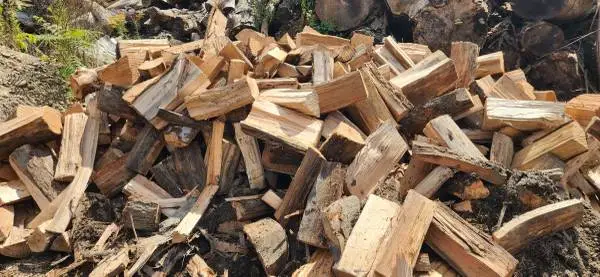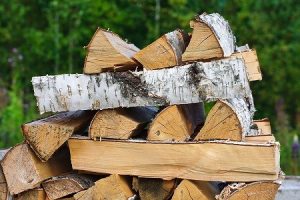Firewood
Need firewood? Reach out to CW Tree and get your split and seasoned firewood delivered.
Guide To Buying Firewood
This buying guide for firewood can help you choose the best kind of firewood for both your indoor and outdoor requirements.

Hardwood
The term “hardwood” refers to a group of trees that grow slowly and produce solid wood. The leaves of hardwood trees often fall off in the autumn and are replaced by new ones in the spring. The following are the most common types of hardwood, all of which are derived from flowering trees:
Oak
Oak is great firewood since it burns slowly. Oak is a thick North American hardwood.
Birch
Although birch is a great fuel, it burns quickly, so it is best combined with Elm and Oak.
Ash
The best wood for a consistent flame and efficient heat. Ash can burn when it is still green, but seasoned ash burns more efficiently.
Walnut
Medium-density walnut firewood burns easily. It’s clean-burning, easy-to-start, and aromatic firewood.
Softwood
Gymnosperm trees, or those that produce softwood from externally unencased seeds, are the source of softwood. Conifers, or trees that produce cones, are by far the most widespread type of softwood. Softwoods have a lower density than nearly all hardwoods. Most typical softwoods used for firewood include:
Cedar
The wood will burn, but it should only be utilized in an open location outside where explosive heat and smoke are less of a worry.
Pine
Pine firewood is great for outdoor kindling. Its sticky sap makes it a great fire starter.
Larch
Larch is an easy-to-light, long-burning wood. Larch is a medium-density wood that lasts longer than Pine.
Wood-burning fires are the best ambiance creating devices, whether you’re telling stories around the fire pit or curling up inside on a wintry night. However, utilizing the incorrect wood will quickly choke up the scene and may result in long-term harm to your home, health, and the environment. The sorts of firewood to stay away from including the following:
Evergreen
evergreen trees often contain high levels of quick-burning resin which can reach high temperatures and result in a chimney fire or even crack your chimney.
Non-local Wood
Foreign firewood spreads invasive insects and diseases. One log can threaten a forest or species. NY state does not allow firewood to be transported outside a 50 Mile radius unless it is treated.
Green Wood
New, green firewood that’s fresh and moist. It’s awkwardly hard to light.
Treated or Painted Wood
Keep painted and treated wood out of your fireplace to avoid hazardous fumes.
Big Wood
Buy firewood that fits your fireplace or fire pit. If it’s too large, you’ll have to recut or split it. It can also be heavy. Big wood is ideal for outdoor wood burners though.
The Best Time to Get Firewood
You can buy seasoned wood year around from CW-Tree, but it is always best to plan ahead and purchase firewood months ahead. Ideally you should buy firewood in the spring to ensure that it is ready for the winter by October. Your wood should be exposed to the sun’s rays and strong winds to properly mature. For optimal air circulation, stack the wood in a crisscross pattern.
Dried Firewood Vs. Fresh Wood
Wood that has been allowed to dry entirely burns faster, creates less smoke, and puts out more heat than fresh, green, or damp wood. Six to nine months of summer seasoning reduces wood’s moisture content.
Hardwoods Vs. Softwoods
CW-Tree sells a mix of hardwood such as Oak, beech, hickory, and ash which all make good fuel. There will not be any softwood mixed in. Hard wood is long-lasting but harder to light than softwoods which last less but their ignition is easier. We do not sell spruce, and pine which are only suitable for fire pit and outdoor areas.
Get the Optimal Size of Wood Pieces
Splitting firewood into medium chunks and 16-18 inches long is ideal for use in home fireplaces and stoves since it is easy to handle. Logs that are too thin will burn too rapidly, whereas logs that are too thick will require more time to season (dry out). Larger firewood can be used in outdoor fires because there are no log size restrictions. CW-Tree sells medium and chunky firewood up to 24-inch length. Chunky firewood over 20” does get heavy.
Is Gas Station Firewood Good?
One of the worst kinds is wood from a gas station or a store. Most of the time, this firewood is sold by the cubic foot or by three-quarters of a cubic foot. It is very expensive and has been kiln dried so it burns very fast.
Go For Split and Seasoned Firewood
Seasoned, dry wood is simpler to split than damp wood. Dry wood has less moisture; thus, cutting and splitting it is easier, regardless of the type of tree from which it was taken. Dry good has a hollow sound, while wood that is still green, has a muffled, thick sound.
Buying Firewood By Weight vs. Volume
Some companies sell by weight so you know exactly what you are getting, but you must ensure that the wood is dry. Most companies including CW Tree sell firewood by volume. The higher the density of the wood, the better value you will receive when purchasing firewood by volume.
Storing firewood outside is ideal. If you want your wood stacked, it should be neatly preserved with the outside exposed to air, covered if possible. Plastic and wooden log storages are the proper ways to store firewood outside. Avoid tree cover and don’t pile logs. Ideally, you should store wood in a well-ventilated, open-sided shed. Storing wood on a pallet, bricks, or plastic prevents moisture absorption. This cleans the wood and reduces insects and spiders. If there is no cover, stack it crisscross to allow for proper ventilation.
Storing Firewood Safely
Firewood can attract woodboring insects that you do not want close to your home. Store firewood 20 feet from your home’s door. To maximize airflow, stack wood a few inches away from any structure.
Besides simply measuring the weight or volume of a firewood order, suppliers and sellers typically handle units unique to the firewood industry.
How Much Is A Cord Of Wood?
Wood is normally sold by the cord or in fractions of a cord (commonly a 1/3) Expect to pay the price of a divided cord. If a full chord costs $300, a 2/3 cord costs $200, and a third cord costs $100. In some cases you will also have to pay a delivery fee.
A face cord is just another name for a third of a cord. A face cord measures 16″ across, 8′ long, and 4′ high. For instance, 4′ wide by 8′ long by 4′ high is the size of a complete rope, which is 128 cubic feet.
CW Tree has firewood year around.
- 1 Full Cords or 3 Face Cords:
- 4 Face Cords:
- 5 Face Cords:
- 2 Full Cords or 6 Face Cords:
- 7 Face Cords:
- 8 Face Cords:
- 3 Full Cords or 9 Face Cords:
- 10 Face Cords:
- 11 Face Cords:
- 4 Full Cords or 12 Face Cords:
- 13 Face Cords:
- 14 Face Cords:
- $225
- $300
- $375
- $450
- $500
- $575
- $650
- $725
- $800
- $875
- $950
- $1000
Free delivery within 15 miles of the Binghamton Airport.
Please Note: CW Tree utilizes a single-axle dump truck for all deliveries. Please note that while we take every precaution to ensure a safe and efficient delivery, we cannot be held liable for any damage to lawns, soft shoulders, driveways, or other surfaces that may occur as a result of truck access.
Customers are responsible for selecting a suitable delivery location and ensuring the area can support the weight and movement of the vehicle. If you have concerns about site conditions, please discuss them with us in advance.
(607) 595-0214
Give us a call when you want help and we will be glad to help.
firewood@cw-tree.com
Drop us a email and we will reach out to you.
Binghamton, NY
Based out of Binghamton, we offer services to Upstate, NY and PA.
